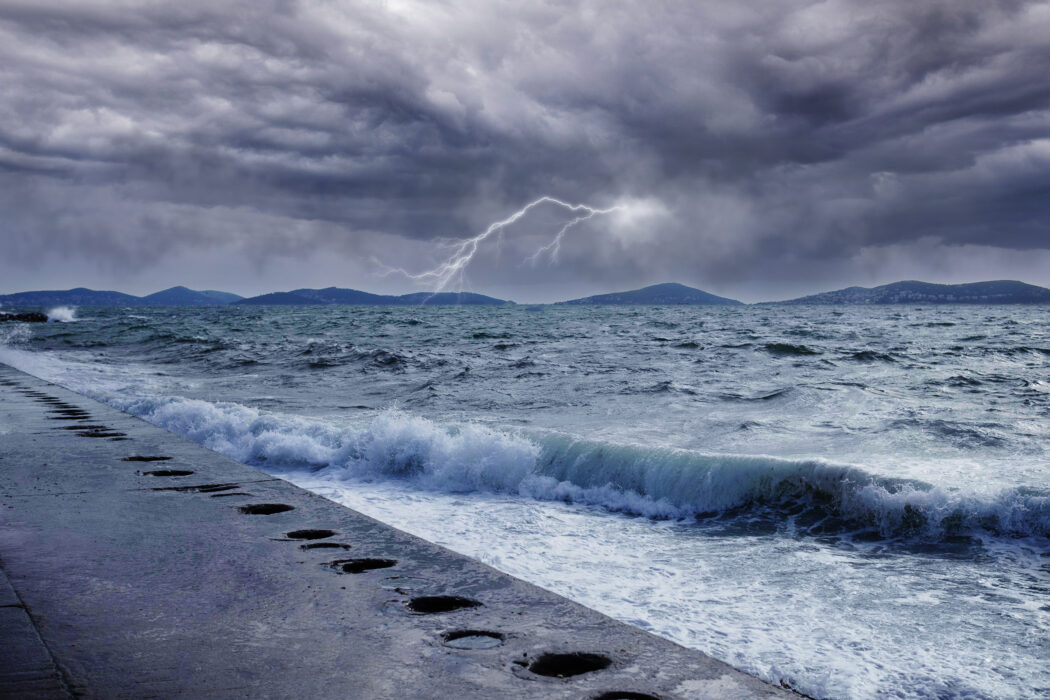A tropical cyclone is an umbrella term for a low-pressure, rotating weather system that forms over tropical or subtropical waters and contains organized thunderstorms but no fronts (boundaries between air masses of different densities). Tropical cyclones progress through stages based on sustained wind speed, which is the average wind speed over a two-minute period. The first stage is a tropical depression, which has maximum sustained winds of less than 39 miles per hour. When those winds reach 39 miles per hour or more, the system becomes a tropical storm, which is also a type of tropical cyclone. Once sustained winds exceed 74 miles per hour, the storm is classified as a hurricane, another type of tropical cyclone.
The Saffir-Simpson Hurricane Wind Scale is a rating or category assigned to each hurricane based on the hurricane’s maximum sustained wind. The higher the rating, the more likely the hurricane is to be dangerous and cause damage upon landing. Hurricanes typically form in the Atlantic Basin, which encompasses the eastern North Pacific Ocean, the Gulf of Mexico, the Caribbean Sea, and the Atlantic Ocean. Hurricanes are named based on a six-year rotating list of names, updated and maintained by the World Meteorological Organization, that is used to identify these storms. The names are chosen alphabetically from the list, alternating between male and female names; however, some letters, such as Q, U, X, Y, and Z, are excluded because there are too few familiar names starting with those letters. Hurricane season officially spans June 1 to November 30, the period when most storms occur, though some have formed outside these dates.
Hurricane Melissa is a storm in the Atlantic basin that was categorized as a Category 5 hurricane on October 28th, when it hit Jamaica, but the next day it was reclassified as a Category 3. That day, October 29th, Melissa hit Cuba and brought heavy rains and flooding to the neighboring countries of the Dominican Republic and Haiti. This hurricane is the third strongest ever recorded in the Atlantic Ocean. While the full damage has not been assessed yet, there is extensive property damage, washed-out roads, power outages, disrupted water systems, and telecommunication failures, making it difficult to contact family members and calculate rainfall in the absence of functioning weather monitoring systems. There have been a total of 61 deaths reported across all the Caribbean islands due to this storm. Many crops have been lost, thousands of Jamaicans have been forced to find refuge in emergency shelters, and many people are still in shelters a week after the hurricane hit.
“My heart goes out to everyone affected during these difficult times. Canada’s initial response is focused on addressing the most immediate and urgent needs in the Caribbean region. We will continue to explore additional ways to support those impacted.”
—Randeep Sarai, Secretary of State (International Development)
The Canadian government has provided $7 million in humanitarian aid to support Caribbean islands. Of this, $5 million is directed to life-saving needs such as food, water, sanitation, health services, protection, and logistics. The remaining $2 million funds the World Food Programme’s Caribbean Regional Logistics Hub, which supplies food and relief to Jamaica. The Canadian Red Cross is coordinating closely with teams in Jamaica, the Dominican Republic, Haiti, Cuba, and other areas, having deployed emergency funds, flood relief, and response teams. In Canada, Toronto has established a portal for secure monetary donations and published a list of local firehouses accepting physical donations for Jamaicans in need. Several businesses in Toronto, particularly Jamaican restaurants, are collecting or sending donations. The Jamaican Red Cross has been preparing shelters and supplying first-aid kits, hygiene products, drinking water, and essentials. Red Cross units in other Caribbean nations have also issued safety alerts, assisted with rescues and evacuations, and provided shelter to those displaced.
The impact of Hurricane Melissa has been severe: damages in Jamaica exceed $8 billion. At least 40 percent of buildings and roads in the island’s western region have been affected.
Infrastructure repairs and rebuilding are necessary due to intense winds, rainfall, and flooding. It is estimated that these damages are equivalent to about 30% of Jamaica’s GDP.
As discussed, hurricanes are extremely powerful natural forces that can cause immense destruction and suffering for the countries they hit and the people affected by them. This is exemplified by the devastation seen in Jamaica in the aftermath of Hurricane Melissa. With the island nation facing $8 billion in damage, there is no telling how long it will take Jamaican citizens and the people of neighboring Caribbean islands to rebuild. There has been an overwhelming rescue and relief response from Canada, demonstrating that even in times of struggle, humans can come together to help one another.








